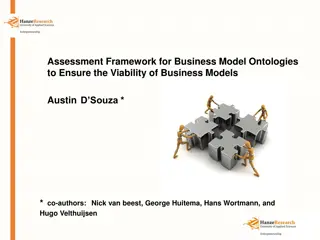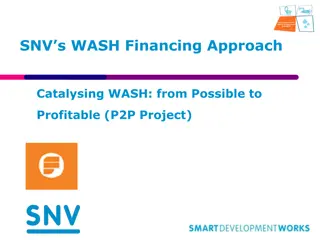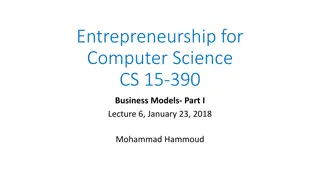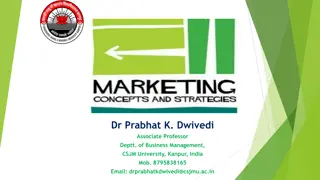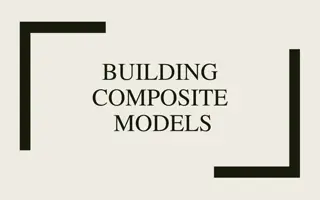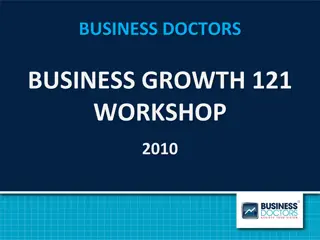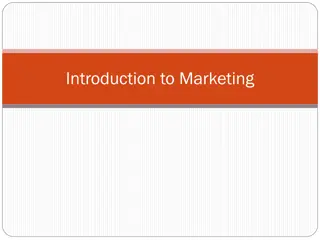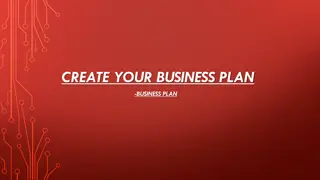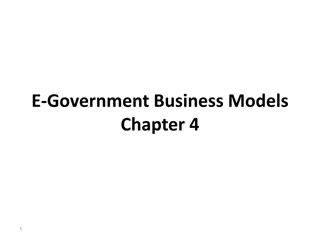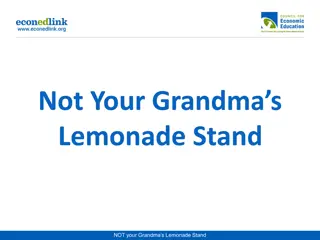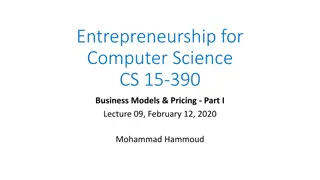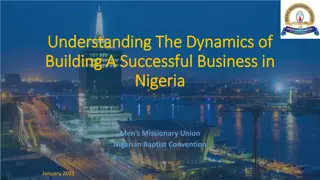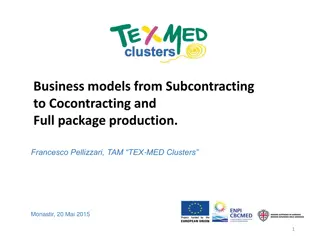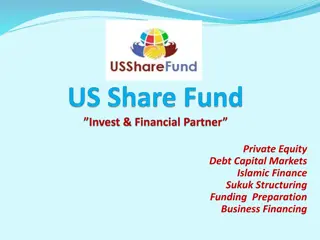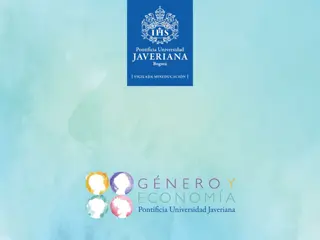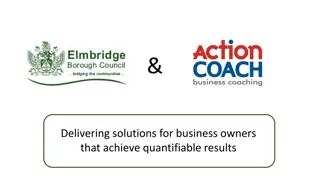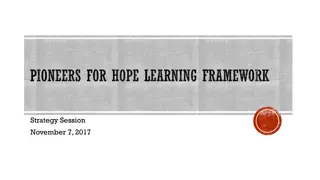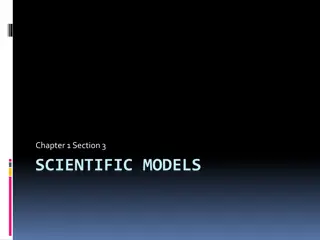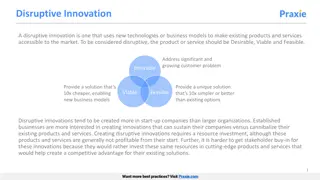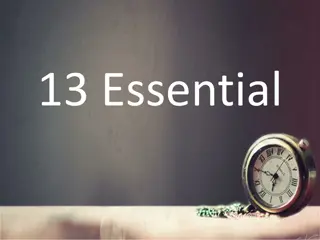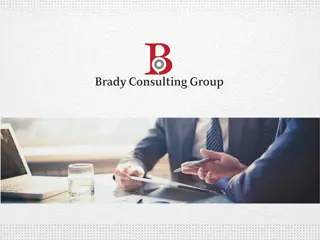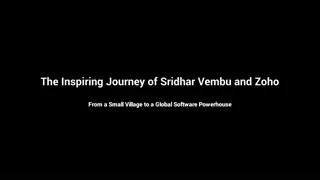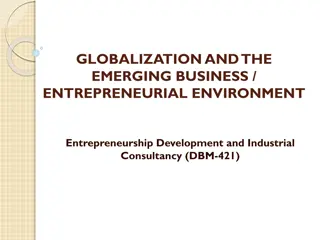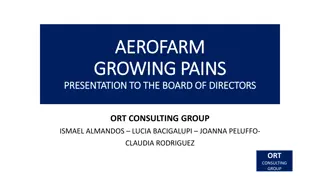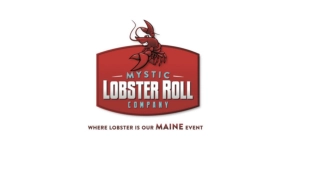Understanding Business Models and Strategies for Profitable Success
Explore various business models such as industrialization of services, loyalty models, online auctions, and more to find ways to make money and cater to market needs effectively. Learn about the key components of a business model canvas and the importance of identifying target markets for successful business planning.
Download Presentation

Please find below an Image/Link to download the presentation.
The content on the website is provided AS IS for your information and personal use only. It may not be sold, licensed, or shared on other websites without obtaining consent from the author. Download presentation by click this link. If you encounter any issues during the download, it is possible that the publisher has removed the file from their server.
E N D
Presentation Transcript
6 Business Model CYCU Prof. CK Farn mailto: ckfarn@gmail.com http://www.mgt.ncu.edu.tw/~ckfarn/cycu 2023.03
Business Model A company's core strategy for profitably doing business. Include: Products or services the business plans to sell Target markets Any anticipated expenses Different models for different types of business e.g. retailer, manufacturing, OEM, . When evaluating a business model as an investor, consider whether the product being offer matches a true need in the market CYCY Prof CK Farn 2
Confusion in Business Models * Industrialization of services business model * Low-cost carrier business model * Loyalty business models * Monopolistic business model * Multi-level marketing business model * Network effects business model * Online auction business model * Professional open-source model * Auction business model * Bricks and clicks business model * Collective business models * Cutting out the middleman model Different people talking about different things Levels, domains, Many specific models * Direct sales model * Distribution business models, various * Franchise * Freemium business model * Pyramid scheme business model * Razor and blades business model (bait and hook) * Servitization of products business model * Subscription business model * Value Added Reseller model * Online content business model * Premium business model CYCY Prof CK Farn 3
Business Model Canvas CYCY Prof CK Farn 4
Business model design template: Nine building blocks and their relationships, Osterwalder 2004. A business model is nothing else than a representation of how an organization makes (or intends to make) money. This can be nicely described through the 9 building blocks illustrated in the graphic below, which we call "business model canvas". CYCY Prof CK Farn 5
Target of business Identify the target the business plans to sell Products Services Multiple targets? CYCY Prof CK Farn 6
Business model canvas Product/ Service Customer Foundation Key Customer Relationships Activities Key Customer Segments Value Partners Propositions Key Channels Resources Cost Revenue Streams Finance Structure CYCY Prof CK Farn 7
Value Propositions What are the values provided to the customers Q: What are the differences between Sogo and 7-11 What are the differences Apple and Xiaomi Different value propositions in the same industry CYCY Prof CK Farn 8
What does Perrier sell? Water? Can water be that expansive? Life Style!! CYCY Prof CK Farn 9
What are the values for Giant Bike? Transportation Health Leisure Life Style Value for U-Bike? CYCY Prof CK Farn 10
Key Partners Who are your suppliers Producer? intermediary/agent? What is your relationship with the supplier? Stranger Co-opetition (competition and cooperation) Apple and Samsung Long term cooperation Apple and FoxConn CYCY Prof CK Farn 11
Arm length relationship Supplier Supplier Customer Focal Supplier Supplier Strategic partners CYCY Prof CK Farn 12
Key Resources What special resources do you have? Human relationships Brands Human resources Technology, pattern Money reserve Special market Physical resources CYCY Prof CK Farn 13
Key Activities Value Chain A business has to decide which activities to pursue Leaving others to its partners Channel Management System Integration Procurement After Sales Service Market Requirements Logistics Production Process Product Design Marketing Sales Production CYCY Prof CK Farn 14
Customer Segments The Target audience of the value propositions TA Business customer (to B) Consumer (to C) Specific segments (e.g. education, military, ) First-time users or replacement market CYCY Prof CK Farn 15
Many types of customers Who are the customers of Google Search? Easy to identify customers in a two-way transaction, but what if there are multi- way exchange? All customers must me treated well CYCY Prof CK Farn 16
Multi-way value exchange Google Search Info release Exposure Web Sites Knowledge Info sources Users Google Head counts Info exposure Ads exposure $$ $$ Product Info / Brand owner Advertisers/ CYCY Prof CK Farn 17
Customer relationship Do you know your customers Why and why not? Single transactions (may repeat) 7-11 How to increase loyalty Long term customers Repeated sales to known members Costco CYCY Prof CK Farn 18
Channels How do you sale your products or services? By yourself Agents Networks The values of channels? CYCY Prof CK Farn 19
Customes and Channels Think about the scenario Airlines Travel agents Consumers Channel conflict If you are an airline, are the travel agents your competitors? CYCY Prof CK Farn 20
The Airline case Membership, VIP cards Accumulate milage, upgrades, free tickets Designate airline Travel Agents Airline Ticket Agents CYCY Prof CK Farn 21
Financial aspects Revenue sources cost driver Investment scale Success factors Estimate revenue scale, cash flow Estimate expenditure scale, cash flow Project investment to achieve positive case flow Cash flow curve Sensitivity analysis CYCY Prof CK Farn 22
Cost driver and structure Personnel costs (direct) Personnel costs (indirect) Inventory Space / rents Marketing / advertising Fixed costs Variable costs Semi variable costs CYCY Prof CK Farn 23
Cost structure Cost structure: pure types Small capital operations Economy of scale Economy of scope Example Producing handmade handicraft Mass production of specific handicraft Machine made customized handicraft CYCY Prof CK Farn 24
Cost structure: operations leverage $ $ Revenue Total Cost Total Cost Fixed cost Revenue Fixed cost Break even Break even Volume Volume Small Capital operations Large scale operations CYCY Prof CK Farn 25
Unit cost Total cost = Fixed cost + variable cost High Fixed cost Cost Unit cost decreases as volume increase Low Low High Volume CYCY Prof CK Farn 26
Economy of Scale and Scope $ $ Total Cost Total Cost Fixed cost Fixed cost Revenue Revenue Unit cost Unit cost Volume Scope Economy of Scale Economy of Scope CYCY Prof CK Farn 27
Assembly line production and Flexible manufacturing Assembly Line Fixed workstation, each accomplish one task Jig, fixture, measurement tools Large batch size Every change of product: stop production for setup FMS Making use of generic tools Automated job shop operations, customized products Batch size can be as small as one CYCY Prof CK Farn 28
Revenue stream How do you make profit? How do you collect money? One time? Every month? Pay as you use? Who pays (Consumer? Other parties?) Multi-party income: television programs, free hand phones CYCY Prof CK Farn 29
Revenue streams Who pays (Consumer? Other parties?) Single stream Multiple streams Hybrid Cross subsidies Freemium Laser printers Razor/Shaver CYCY Prof CK Farn 30
Payments Membership Licensing Pay as you use Advertising Cost per exposure? Cost per impression? CPI, CPM Cost per click? CPC Cost per action? Cost per Sales? CPA, CPS Transaction fee CYCY Prof CK Farn 31
Inventory cost Assuming: a company with 1 billion revenue, and the raw material cost is 60% If inventory (raw material, WIP and finished goods) cycle time is 120 days Total average inventory 200 million If inventory cycle time is 30 days Total average inventory 50 million Inventory cycle 120 30 days Inventory reduction 150 million Assuming 5% cost of capital, savings amounts to 7.5 million! CYCY Prof CK Farn 32
CCC: Cash Conversion Cycle Inventory cycle + Accounts receivable Accounts payable Cash Rich Operations Negative CCC Cash Poor Operations Positive CCC CYCY Prof CK Farn 33
Financial considerations Cost structure and revenue streams Operations leverage Economy of scale Economy of scope Cash rich/Cash poor operations Value propositions to generate income CYCY Prof CK Farn 34
Summary: Business Models A hybrid of the nine factors What business are you in Take department stores as an example Buy and sell Consign for sale on commission Property rental CYCY Prof CK Farn 35




